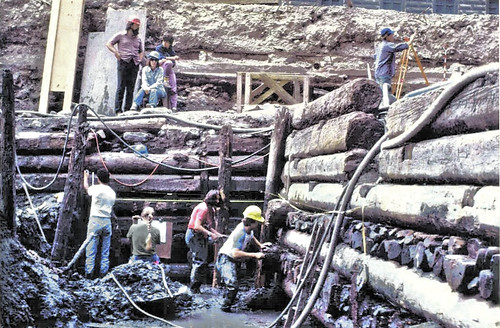Former site of the New York US Federal Assay Office - 1984

NYC Urban Archaeology ca. 1984 - former site of the US Federal Assay Office, where precious metals were evaluated. In 1983 it was "...sold for $27 million, making it the most valuable piece of Government real estate ever put to public auction" - NY Times. The smoke stack was sandblasted for ~ $100k in gold that went up the chimney. It had a "floating vault" the guards could see under and built out of vertical interspersed railroad track to make it impenetrable. These are the remains of the 19th century wharves that were under it, when it was used as part of the lower east side of Manhattan seaport, the prevailing wind and currents favored sail.
At some point, the lawyers were mad at the Landmarks Commission, being asked to use the same stone as in the building to be in the curbs. The developer, HRO, working for the consortium that became National Westminster Bank had already made $17 million "in design changes" and like some other new building projects in NYC, had to buy the quarry that went out of business before the building was finished, perhaps (a NYU library, and a few others, one more recent) and after a spending ceiling impasse, two archaeology projects and artifacts (over 1 million estimated from this site, the largest to date) and materials went to a large engineering company in New Jersey with an archaeology section.
Later the artifacts and report which they finished for this site, not the already approved "Augustine Heerman Warehouse Site" report of old New Amsterdam, were returned to NYC. Recently all the collections from lower Manhattan have been shipped to Albany, NY where they are supposed to be unified under a computer catalog system covering them all. The South Street Seaport Museum (now the "Seaport Museum of New York" [2010]) said it could no longer afford the space to store the boxes of artifacts. One suggestion by the PANYC organization (Professional Archaeologists of New York City) was that some of the unusually empty spaces over on Governors Island, just across the harbor by ferry from the now closed "New York Unearthed" archaeology museum (closed post 9/11/01), once on the site of Herman Melville's former abode while a U.S. Customs agent, would be the better repository of materials NYC developers and archaeologists and others in city administration had worked to safeguard for future study.I think ESPN are near a place in Connecticut where Isaac Allerton, a Puritan on the ship the Mayflower settled in Connecticut. His ship, in coastal trade from Maine to New York, by-the-way, was the Hope. He had a warehouse at the East River edge just outside the Wall and Water Gate, next to the old ferry to Brooklyn and had a business there, cited later as one of the top four in old New Amsterdam. Free "blacks" and presumably others worked his cargoes. It was presumably under the parking lot currently slated to be developed as "250 Water Street" someday, in the city's seaport historic district. A monument from the Mayflower Society was erected in 1903 at the location since lost.
His remains have been moved to the cemetery Yale University maintains as part of their campus in New Haven. Some of the stone for the Brooklyn Bridge was quarried there, “out back”. We have a large street in the Bronx named Allerton Avenue, an exit between the zoo and the botanical gardens on America's oldest automobile parkway, the Bronx River Parkway. Some of its older sections are part of the park, in the redesign for faster traffic.
Engineers have stated that the new water tunnel being excavated in rock about 900 ft. below the street has only one of two places to come up to efficiently connect with the water network of Lower Manhattan: either at the “250 Water Street” site, currently a parking lot, mostly for the patrons of the “Seaport Museum of New York” owned by the real estate developers, who were a part of the 42nd St. revitalization or at the fairly recently opened 1 Police Plaza, in a lot once slated to be a small park named after a famous Catholic, Mother Cabrini also used as parking. At one time the former Mayor Dinkins’ administration would have condemned the seaport parking lot. Across the street is a National Register of Historic Places building at 251 Water Street.
No comments:
Post a Comment